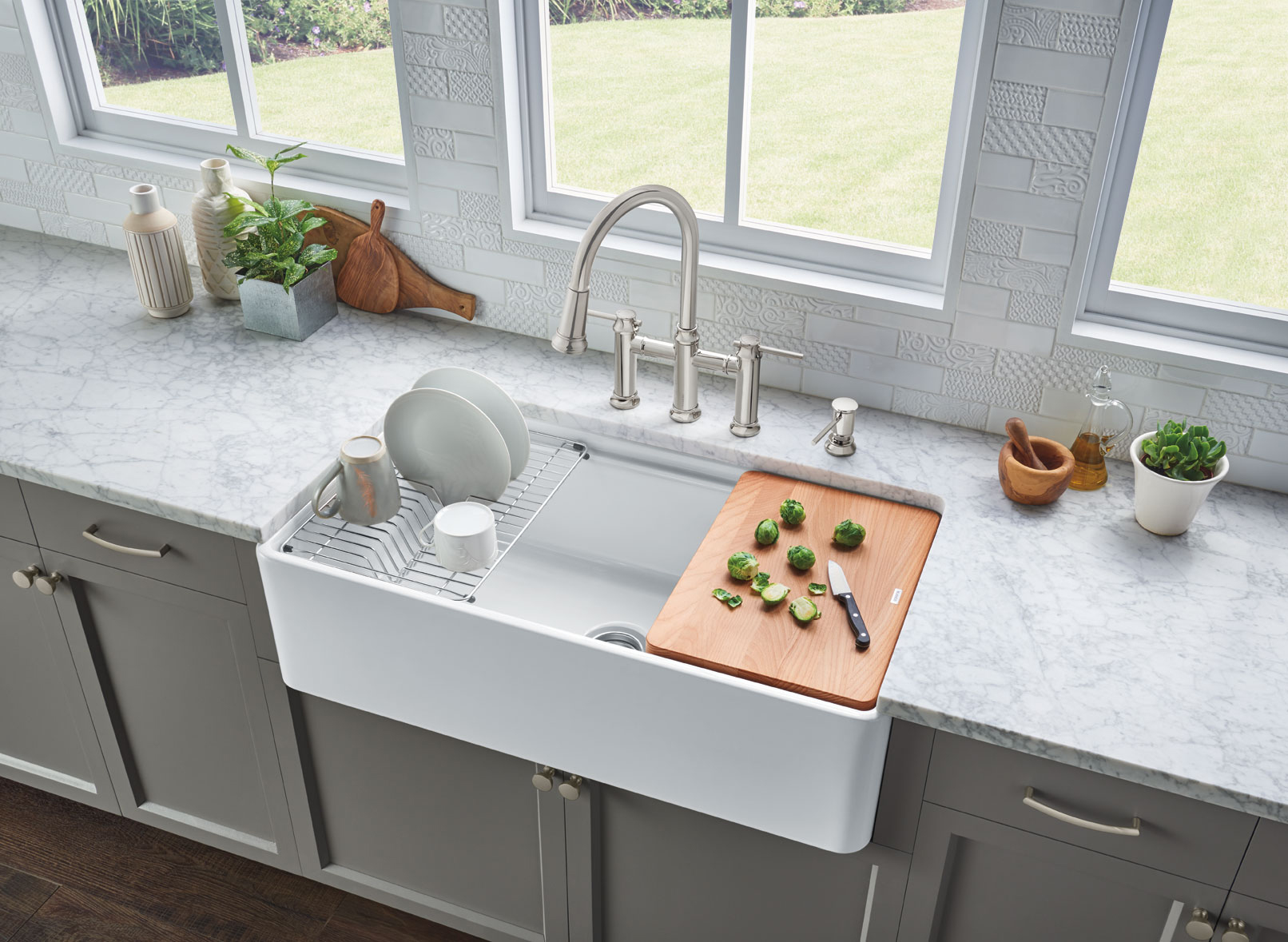Kitchen Sink Plumbing Basics
Finding the right plumbing for your kitchen can be a challenge, especially if you’re a beginner in home renovations. If you’re designing a kitchen from scratch, it’s important to know the basics of kitchen sink plumbing. This includes understanding the different types of plumbing, the materials used, and the installation process. Knowing all of this will help you create a kitchen that meets all your plumbing requirements and still looks great.
Kitchen sink plumbing involves connecting pipes and tubing within your kitchen’s walls or floor and through your sink. Pipes and tubing can range in size and in materials, from brass, copper, or galvanized steel, just to name a few.
Another important aspect of kitchen sink plumbing is the installation. Depending on the sink and the type of faucet you choose, the installation process can be complicated. It’s important to know what type of water connections you need and how to install them correctly. If you have to reroute some of the existing plumbing for your new sink, this can add to the complexity of the job.
Kitchen Plumbing Design Considerations
The design of the kitchen sink plumbing should be taken into account when you’re planning the layout of your kitchen. It’s important to consider the placement of the pipes, as this can affect access to important parts of the kitchen. Plumbing fixtures such as the sink drains, dishwashers, and garbage disposals should also be kept in mind when planning your kitchen design.
In addition to the placement of the pipes, you will also need to consider the layout of the pipes themselves. This includes understanding the size of pipe required, the route of the pipe line, and the amount of water each pipe needs to handle. The pipes need to be able to withstand high temperatures and pressure, so they must be factored into the overall design of the kitchen.
Kitchen Sink Drain Pipe Installation
Installing kitchen sink drain pipes can be a daunting task, especially if you’re a first-time DIY-er. To successfully complete the job, you’ll need to understand the process and the materials needed. This means knowing how to properly fit the pipes and the different types of plumbing materials required.
You’ll first need to consider the type of sink you are installing and its corresponding drain pipe. This is because different types of sinks require different types of pipes. You’ll also need to measure the length and diameter of the drain pipe that needs to be installed. The pipe should be long enough to reach the necessary length and height of the sink.
Once you have the drain pipe in place, you’ll need to connect the sink’s plumbing fixtures to the drain pipe. This involves joining the drain pipe to the sink’s faucet with a special type of ball valve. This helps to regulate the water flow. You’ll also need to connect the sink’s air gap to the drain pipe to prevent the buildup of water pressure in the plumbing system.
Understanding Kitchen Plumbing Basics
Kitchen plumbing basics are essential knowledge for any homeowner. This includes understanding the different types of plumbing fixtures, such as sinks and faucets, as well as the different types of pipes used in the plumbing system.
It’s important to understand the different types of fittings and connectors used for joining pipes together. There are various types of fittings and connectors available in the market, such as elbow, connector, and tee fittings. Additionally, each type of piping material has its own unique requirements for installation.
The water supply is an important part of any plumbing system. It’s important to understand the different types of water supply, such as hot and cold water, and the different pressure requirements for each of them. Additionally, you should familiarize yourself with the different valves used to control the flow of water in different parts of the plumbing system.
How to Install Kitchen Sink Plumbing
Installing kitchen sink plumbing can be a tricky business, especially if you’re not an experienced DIY-er. Fortunately, with the right knowledge, you can easily install your sink’s plumbing system. The first step is to understand what materials and tools you need to complete the job.
You will need to prep the area where the sink is going to be installed. This includes removing the old pipes and grinding or cutting them away. You will also need to measure the length and width of the pipes needed to connect the sink to the plumbing system.
Once you have the pipes in place, you will need to join them together with the right type of fittings and connectors. This is where understanding of different types of piping materials comes in handy. Each type of piping material requires its own joining process.
Kitchen Plumbing Plans & Requirements
Before beginning any kitchen plumbing project, you should be clear about the plan. This means having a set of plans outlining the size and placement of pipes, including the materials used. Additionally, you should know the type of sink and plumbing fixtures that will be installed, as well as the types of valves that will be used.
It’s also important to familiarize yourself with the local requirements for kitchen sink plumbing. These requirements are usually set by local building codes. Make sure that you know the local codes and that you adhere to them when installing your kitchen sink plumbing.
Kitchen Sink Plumbing Layout
Once you have all of the necessary information, you can begin to plan the layout of your kitchen sink plumbing. This includes deciding on the location of the sink, the layout of the pipes, and the placement of the plumbing fixtures. It’s important to have a good understanding of both the size and shape of your sink, as well as the type of piping materials that will be used.
A key part of planning the layout of your kitchen sink plumbing is to understand the different water pipes that will be installed. This will help you ensure that you install the correct size of pipes and that they are correctly joined together.
It’s also important to pay attention to the position of the pipes. You’ll need to make sure that they’re joined together in a way that won’t interfere with the functionality of the kitchen. To help with this, you can draw a plan of your kitchen sink plumbing and mark out the position of the pipes.
Kitchen Sink Plumbing Installation Cost
Once you’ve decided on the placement and layout of your kitchen sink plumbing, you’ll need to factor in the installation cost. When calculating the cost of kitchen sink plumbing installation, there are several factors to consider.
The cost of installation depends on the type of sink and the complexity of the job. Generally, the more complex the job is, the more it will cost. Additionally, depending on the type of piping material and the length of the pipe, you might need to pay extra for the materials.
The amount of labour you need to pay will also impact the cost of installation. If you’re installing the plumbing yourself, you’ll need to factor in the cost of tools and supplies. A professional kitchen sink plumbing installation will typically cost more than a DIY one, but it will save you time and ensure your pipes are installed correctly.
Kitchen Sink Plumbing 101: Becoming a Pro
If you’re looking to become a kitchen sink plumbing pro, there are certain key steps you need to take. To start off, it’s important to have a good understanding of the different types of pipes and plumbing materials and the tools and supplies needed for the job.
It’s also important to understand the different types of fittings and plumbing connectors and how to join different pipes together. Additionally, you’ll need to become familiar with the local plumbing codes and regulations in order to ensure that the plumbing is installed up to code.
Once you gain a good understanding of the basics of kitchen sink plumbing, you’ll need to practice these skills. This can involve taking on some DIY projects or working with a professional to gain experience with different types of plumbing fixtures and installation methods.
Kitchen Sink Plumbing Diagram
Before you begin installing your kitchen sink plumbing, it’s important to create a diagram of the project. This diagram should include the location of the sink, the type of sink, and the type of plumbing fixtures that will be installed. Additionally, it should include the measurements of the pipes and the length of the pipes.
Creating a diagram is also helpful for visualizing the position of different pipes and fittings and measuring the distance between them. This allows you to ensure that the pipes are correctly and safely installed. Additionally, if your project involves rerouting existing pipes, a diagram is a great way to show your plumber the new layout.
Creating a plumbing diagram can also save time and money, since it allows you to plan out the project ahead of time and identify any potential issues. It also gives you a chance to double-check the measurements of the pipes and check that you have the right tools and materials in hand before you start the installation process.
Kitchen Design Plumbing Standards & Considerations
 Creating a desirable kitchen design requires attention to detail, and the
plumbing
is no exception. Good kitchen plumbing is essential to any homeowner, and the process of deciding how best to handle the
plumbing
for your kitchen design can be overwhelming. Plumbing requirements depend on the layout and type of fixtures you choose, as well as local building codes. Here are general plumbing guidelines and
considerations
to help you create an efficient kitchen design.
Creating a desirable kitchen design requires attention to detail, and the
plumbing
is no exception. Good kitchen plumbing is essential to any homeowner, and the process of deciding how best to handle the
plumbing
for your kitchen design can be overwhelming. Plumbing requirements depend on the layout and type of fixtures you choose, as well as local building codes. Here are general plumbing guidelines and
considerations
to help you create an efficient kitchen design.
Installing Kitchen Plumbing
 When installing kitchen
plumbing
, you must follow the regulations set by local building codes or the regulations of the specific project you are working on. Depending on the area, general kitchen
plumbing
may include:
When installing kitchen
plumbing
, you must follow the regulations set by local building codes or the regulations of the specific project you are working on. Depending on the area, general kitchen
plumbing
may include:
- Drain lines
- Fixture fittings
- Vent fans
- Water hoses
- Pipes and Gas lines
Plumbing Standards & Regulations
 Once your
kitchen plumbing
is installed, you must make sure it meets local plumbing standards. Some guidelines to keep in mind include:
Once your
kitchen plumbing
is installed, you must make sure it meets local plumbing standards. Some guidelines to keep in mind include:
- Check to make sure all pipes are properly positioned and secure
- Ensure all fixtures are properly connected and distanced from each other
- Check that all appliances, such as dishwashers and disposals, are up to code
- Make sure no leakage is present in any of the pipes
Inspection & Maintenance
 Finally, make sure your
kitchen plumbing
is inspected regularly by a professional plumber. This is to ensure that all fixtures and appliances are functioning properly, and to detect any signs of damage or wear that may have occurred. Additionally, regular maintenance and cleaning is necessary to prevent buildup in the
plumbing
system and to extend the life of your kitchen
plumbing
system.
Finally, make sure your
kitchen plumbing
is inspected regularly by a professional plumber. This is to ensure that all fixtures and appliances are functioning properly, and to detect any signs of damage or wear that may have occurred. Additionally, regular maintenance and cleaning is necessary to prevent buildup in the
plumbing
system and to extend the life of your kitchen
plumbing
system.















































































